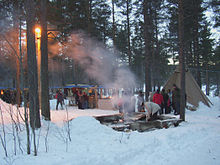Jokkmokk winter market
At the end of February 1605, the first official seed market was held in Jokkmokk , Sweden , which is still called Jokkmokks Vintermarknad ("Jokkmokks Winter Market ") and which has started every year on the first Thursday in February and ends on the following Saturday. This makes it one of the oldest markets in the world.
history
As early as the 16th century, the Jokkmokk area was a trading post for Sami , Swedes and Finns in the region around the Lule River , although there was no permanent settlement there at that time. It was only when King Karl IX set the place as one of various marketplaces in the Lappmark in 1602 that the first settlement developed around the newly built church.
In addition to the simplification of the trade in the scattered Sami wandering in the wilderness , the establishment of the market clearly had colonialist features. This applied both to the missionary work by the church, which mainly took place at baptisms and weddings, and to the expansion of the power of the Swedish kingdom to include the indigenous people of Lapland . The market served as a court of law, payment center for taxes and a checkpoint for recording the Sami population. Initially, however, the state tasks were taken on in trust by Finnish traders - so-called Birkarlar - so that they were able to secure wealth and influence over time.
In the first time the market was held around January 25th during the papal mass and lasted about two to three weeks. After the forced relocation of the Sami in the 18th century and the increasing settlement by Sweden, the importance of the market declined, so that it only lasted two days until the 1940s. For the 350th anniversary in 1955, the market time was extended to three days and the number of market stalls increased significantly in order to make the event interesting for tourism. This orientation became more and more important in the following years.
The modern market
Nevertheless, Jokkmokk's winter market is still primarily the social event of the Sami people in all of Scandinavia including Finland and the Russian Kola Peninsula . Since the 1990s, more and more young seeds have been remembering their roots and putting on their traditional costumes for the winter market . In addition to the baptisms and weddings that are still taking place, clothing, fabrics, skins, reindeer meat, wood carved, birch bark and other raw materials for handicrafts are for sale at stalls, in school buildings, community rooms and workshops . Concerts by Sami musicians, dance evenings, fashion shows and art exhibitions take place at the same time. Reindeer sleigh races are held on the frozen Talvatis Lake . For the non-Sami visitors there is a wide range of Sami handicrafts and a historical market in “ living history manner ”. During the market week, which is the coldest time of the year, around 40,000 people visit the small town, so that all accommodation, including the gyms and Sami tents, is fully booked months in advance.
For the winter market, special trains run on the Inlandsbahn , the northern part of which is almost entirely without traffic in the winter months .
photos
- The 400th anniversary fair in February 2005
Visiting a traditional lavvu (sam. Tent)
Ice sculpture in the form of a Sami shaman's drum
Web links
Individual evidence
- ↑ Rolf Kjellström: Samernas live. Swedish. Carlsson Bokförlag, Kristianstad 2003, ISBN 91-7203-562-5 .
- ↑ http://www.jokkmokkguiderna.com/jokkmokks_vintermarknad_historia
- ↑ Website of the organizer
- ↑ Inlandsbanan's website










